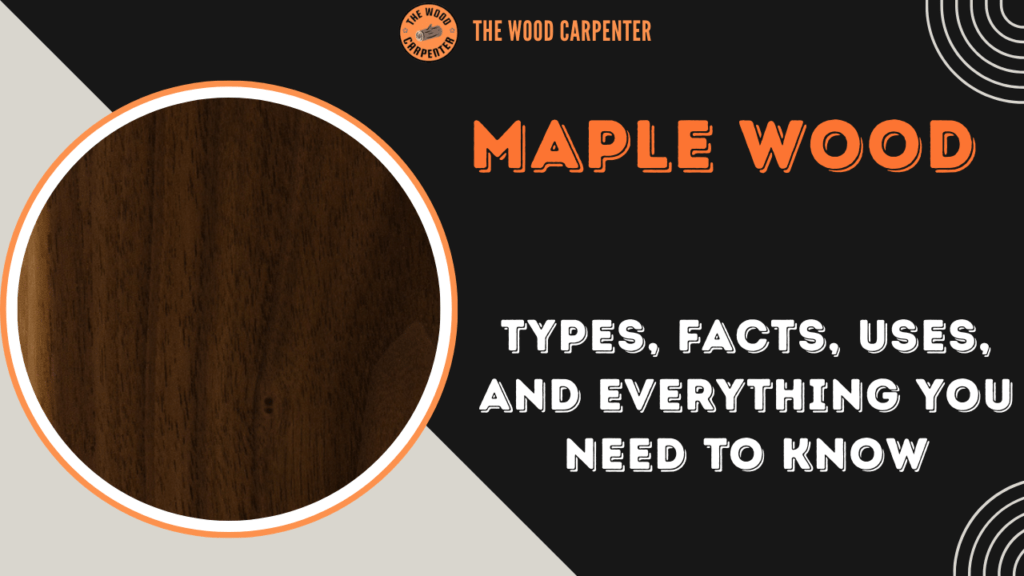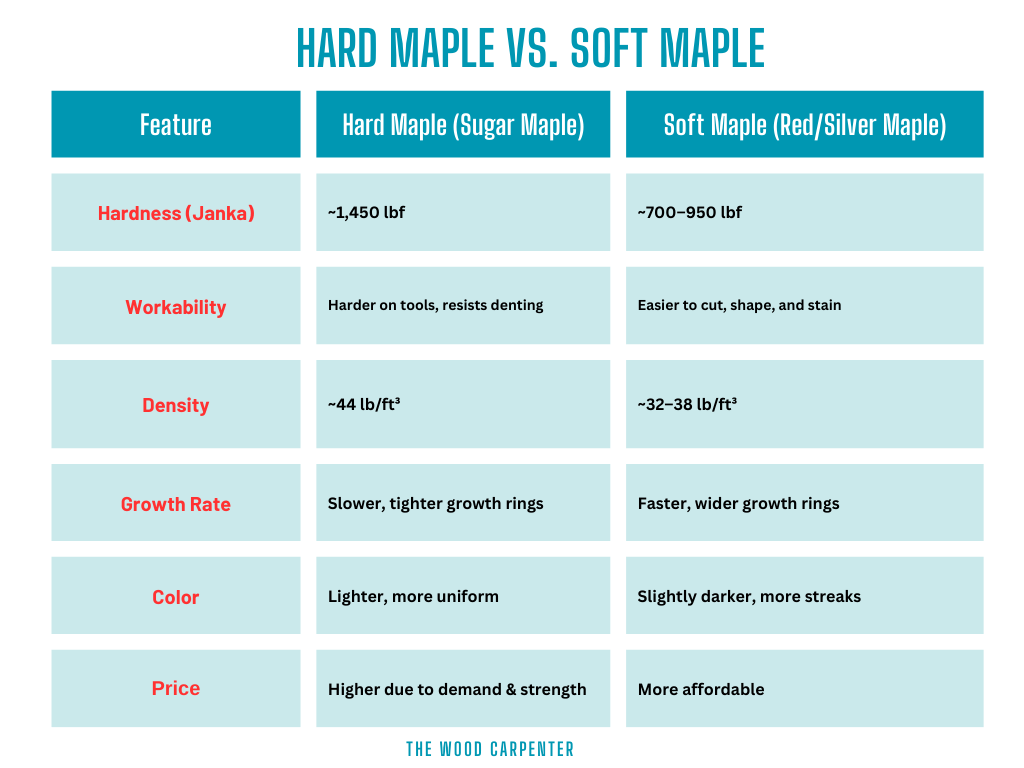
Maple Wood: Types, Facts, Uses
Maple is simply one of the most versatile and popular hardwoods in the world. It has long been prized for its hardness, uniformity and a light cream color. This maple wood has been popularly used for furnitures, flooring, cabinetry,sports equipment and even they are used in the musical instruments.
Could a craftsman actually work it with his hands or look lovingly upon it, as a homeowner? This article will help you gain some insight about the types, features and uses of elastic, and why does people use it so many times.
What is Maple Wood ?
Maple is derived from the Acer tree type of which there are more than 130 global specimens. The following are some of the species of commercial value used as lumber in woodworking:
- Hard Maple (Sugar Maple / Rock Maple, Acer saccharum) – This also is the tree used to make maple syrup. It is famous for its power and endurance.
- Soft Maple (Red Maple, Silver Maple, Box Elder, etc.) – There are a few different types of species in this group and while all may have the same color and look as Hard Maple, they’re softer and lighter.
Maple trees are grow widely in the North America, Europe, and Asia, with sugar maple especially abundant in the U.S. and Canada.
Hard Maple vs. Soft Maple
People often wonder what is the difference between hard and soft maple. Here’s a breakdown:

👉 Key takeaway: Hard maple is ideal for high-impact applications where durability is critical, while soft maple is a cost-effective alternative for furniture and cabinetry.
Appearance and Grain
- Color: It’s color ranges from creamy white sapwood to reddish-brown heartwood.
- Grain: Mostly it is fine and straight, which gives it a smooth finish.
- Special Figures: Maple often displays unique and desirable patterns such as:
- Birdseye Maple – Tiny, eye-like swirls.
- Curly / Fiddleback Maple – Rippling, wavy grain.
- Spalted Maple – Dark lines occurring naturally from fungi.
These figured forms are highly valued in luxury furniture, veneers, and musical instruments.
Strength and Durability
- Janka Hardness: Hard maple ~1450 lbf this is one of the toughest Domestic Hardwoods.
- Durability: Fantastic for indoors, and it isn’t great for outdoor furniture without being treated.
- Lifespan: A good quality maple furniture will last you around 30 years or so given good care.
Common Uses of Maple Wood
Its strength and beauty give it wide applicability:
- Furniture & Cabinets – The creaminess of maple is perfect for everything from contemporary to traditional homes.
- Flooring – For high-traffic areas, this is perfect..
- Sports Equipment – Used for bowling alleys, pins, baseball bats and pool cues.
- Musical Instruments – Preferred choice wood in violins, guitars and drum sets.
- Kitchenware – Cutting boards, small blocks of wood for good cutting and rolling pins (food safe).
Workability and Finishing
- Hard Maple: Can be difficult to machine because of its density, sometimes burns when cut. Best to use sharp tools.
- Soft Maple: Easy to work with, takes stain well—often used as a cherry or walnut substitute when stained.
- Finishing: Maple looks great with a clear finish, but during the staining, it can sometimes appear blotchy. It is recommended to use a pre-stain conditioner or gel stain for even coloring.
Also read:
Ambrosia Maple: The Secret Weapon of Woodworkers!
Sustainability and Eco-Friendliness
- Maple is also an environmentally friendly wood. It is not rated by CITES or on the IUCN Red List.
- Maple trees are excellent for carbon capture, absorbing about 22 lbs of CO₂ per year.
- They grow quickly (particularly red and silver maples), which means they will be readily available into the future.
Interesting Facts About Maple Wood
- Ancient Origins – Maple trees have been around for 60 million years or more.
- Maple Syrup – It takes 40–50 gallons of sap to produce one gallon of syrup.
- National Symbol – The maple leaf is the national emblem of Canada.
- Musical Fame – Stradivarius violins were made with figure maple wood!
- Color Change – Maple will naturally darken when exposed to light, creating a beautiful golden patina.
- Durability – Hard maple is tough enough for dance halls and bowling alleys.
- Unique Figures – Birdseye, curly and spalted figure are some of the most sought after decorative woods.
FAQs about Maple Wood
1. Is maple wood strong?
Yes. The Hard maple is among the hardest domestic woods around with a Janka rating of ~1450, which shows that it’s great for a heavy use.
2. What’s the difference between hard and soft maple?
Hard maple (sugar maple) is denser, stronger, and it is lighter in color. The Soft maple includes several species that are easier to work with and they are more affordable.
3. Does maple wood darken over time?
Yes. It naturally develops a honey-gold patina when they are exposed to light and air.
4. Is maple wood good for furniture?
Absolutely. It is durable, attractive, and they are widely used in furniture, cabinets, and flooring.
5. Is maple eco-friendly?
Yes. Maple is a sustainable, widely available, and it absorbs significant amounts of carbon dioxide.
Maple Wood Flooring
6. Is maple wood good for flooring?
Yes. Hard maple is very durable, which makes it ideal for high-traffic flooring, gyms, and dance halls.
7. Does maple flooring scratch easily?
Maple is hard and resists dents, but scratches can show more on its light surface, so proper care is needed.
Maple Wood Color
8. What color is maple wood?
Maple sapwood is light cream to nearly white, while heartwood can be light reddish-brown.
9. Does maple wood change color over time?
Yes. It ages and darkens naturally, becoming a rich golden or honey hue with time and sunlight.
Bird’s Eye Maple Wood
10. What is bird’s eye maple?
It is also a rare figure in hard maple itself, with tiny inward-swirling “eye” patterns that are treasured because of its distinctive beauty.
11. Is bird’s eye maple expensive?
Yes. It also, however, is relatively rare and difficult to work with (and it looks a lot different from the regular maple wood you see around).
Maple Wood Cutting Board
12. Is maple wood safe for cutting boards?
Yes. Hard maple is non-toxic and safe – without treatment, the wood can even resist bacteria growth, which may make it the best wood for cutting board applications.
13. How long does a maple cutting board last?
With proper care and oiling, a maple cutting board can last many years without warping or cracking.
Final Thoughts
Maple provides every thing one might want in one of the most durable and handsome woods supplied by nature. Hard maple is suitable for flooring, butcher blocks and musical instruments; soft maple makes an affordable choice for cabinets and furniture. Sustainable, friendly to the environment and with swirling grain detail this is a much sought after timber, one of the most popular hardwoods in the world.

